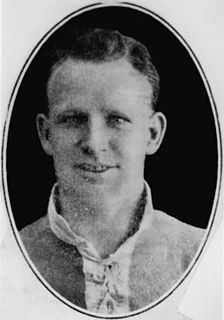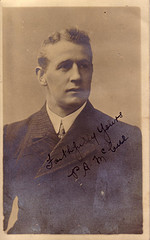The Australian national rugby league team, the Kangaroos, have represented Australia in senior men's rugby league football competition since the establishment of the 'Northern Union game' in Australia in 1908. Administered by the Australian Rugby League Commission, the Kangaroos are ranked second in the RLIF World Rankings. The team is the most successful in Rugby League World Cup history, having contested all 15 and won 11 of them, failing to reach the final only once, in the inaugural tournament in 1954. Only five nations have beaten Australia in test matches, and Australia have an overall win percentage of 67%.
The State of Origin series is an annual best-of-three rugby league series between two Australian state representative sides, the New South Wales Blues and the Queensland Maroons.

Herbert Henry Messenger, nicknamed "Dally" and sometimes "The Master" was one of Australasia's first professional rugby footballers, recognised as one of the greatest-ever players in either code. He played for New South Wales in the first match run by the newly created 'New South Wales Rugby Football League' which had just split away from the established New South Wales Rugby Football Union.

Ernest Arthur "George" Anlezark, also known as Alec, was an Australian rugby league and rugby union player – a dual-code rugby international.

Patrick Bernard "Nimmo" Walsh was a pioneer Australian representative rugby union and rugby league footballer, a dual-code international, who saw active duty with the Australian Imperial Force in the first World War. He represented the Wallabies in three Tests in 1904 and the Kangaroos in three Tests on the first tour of Great Britain in 1908–09.

John Thomas "Tom" Gorman (1901–1978) was an Australian rugby league footballer. He was a centre for the Australian national team. He played in 10 Tests between 1924 and 1930 as captain on 7 occasions.
Wilhelm Gustaf "Bill" Heidke (1883–1959) was a pioneer Australian rugby league player. He was a backline player for the Australian national team. He played in 4 Tests between 1908 and 1910 as captain on 1 occasion.

Patrick Aloysius "Paddy" McCue was an Australian representative rugby union player and pioneer rugby league footballer.
Viv Farnsworth (1889–1953) was an Australian professional rugby league footballer who played in the 1910s and 1920s. He played for Newtown, Wests, New South Wales and Australia, he also represented Australasia. He primarily played as centre and is considered one of the Australia's finest footballers of the 20th century
A test match in rugby league football is a representative match between teams representing members of the Rugby League International Federation.

Dan Dempsey was an Australian rugby league national and Queensland state representative player. He played his career at hooker and is considered one of the nation's finest footballers of the 20th century.

Eric Weissel (1903–1972) was an Australian rugby league footballer, a state and national representative goal-kicking five-eighth. He played his club career in country New South Wales and is considered one of the nation's finest footballers of the 20th century.

The 1908–09 Kangaroo tour of Great Britain was the first ever such tour for the newly-formed Australia national rugby league team. The tour was to England and Wales and coincided with the first Wallabies Rugby Union tour of Great Britain, which in hindsight put the Kangaroos in a tough position. The game of rugby league was not yet twelve months old in Australia however a New Zealand side had already toured to Britain, Australia had encountered New Zealand during the 1908 season and the pioneer Australian leaders of the game were keen to match up against the Northern Union founders of the code.

Thomas Bertie "Bert" Jenkins was a Welsh rugby union, and professional rugby league footballer who played in the 1900s, 1910s and 1920s. He played club level rugby union (RU) for Troedyrhiw RFC and Mountain Ash RFC, and representative level rugby league (RL) for Great Britain, Wales and Lancashire, and at club level for Wigan, as a centre.
John "Johnny"/"Johny" Thomas was a Welsh rugby union, and professional rugby league footballer who played in the 1900s, 1910s and 1920s. He played representative level rugby union (RU) for Glamorgan and Monmouthshire, and at club level for Maesteg RFC and Cardiff RFC, as a full-back or scrum-half, i.e. number 15, or 9, and representative level rugby league (RL) for Great Britain, Wales, Glamorgan and Lancashire, and at club level for Wigan, as a stand-off or scrum-half, i.e. number 6, or 7.

The 1911–12 Kangaroo tour of Great Britain was the second ever Kangaroo tour and was actually a tour by an "Australasian" squad including four New Zealand players in addition to twenty-four Australian representatives. It took place over the British winter of 1911–12 and this time, to help promote the game of Rugby league in New Zealand, the Northern Rugby Football Union invited a combined Australian and New Zealand team. They became the first tourists to win the Ashes. and the last to do so on British soil for over half a century. The tour was a success in performance and organisation. Matches were well attended, the squad's touring payments were maintained throughout and the players all shared in a bonus at the tour's end.

The 1921–22 Kangaroo tour of Great Britain was the third ever Kangaroo tour. Again an Australasian side rather than an Australian team alone travelled to Great Britain to contest the Ashes. Coached by Arthur Hennessy and captained by Les Cubitt, the Kangaroos travelled on the RMS Tahiti to England for best-of-three series of Test matches against Great Britain for the Ashes. The tour took place during the 1921–22 Northern Rugby Football Union season and also featured matches against several of the clubs in that competition as well as other representative teams. The tour also involved some degree of player misbehaviour, with one young footballer almost sent home from San Francisco because of all the broken glasses following a drinking session on board the team's ship.
Alex Watson (1931–2002) was an Australian professional rugby league footballer who played in the 1950s. An Australian international and Queensland interstate representative three-quarter back, he played club football in the Brisbane Rugby League premiership for Western Suburbs.

The 1910 Great Britain Lions tour of Australia and New Zealand was the first international tour of the Great Britain national rugby league team, "The Lions". They played the second ever Ashes series against Australia, and their first as the visiting team, before travelling to Auckland to take on New Zealand. The tour was a huge promotional and financial success for what was then known as the "Northern Union" game and helped set the pattern for regular, alternating test match series between Britain and Australia. It is regarded as one of the most important events in the history of rugby league.
The 1921 New Zealand rugby league season was the 14th season of rugby league that had been played in New Zealand.













